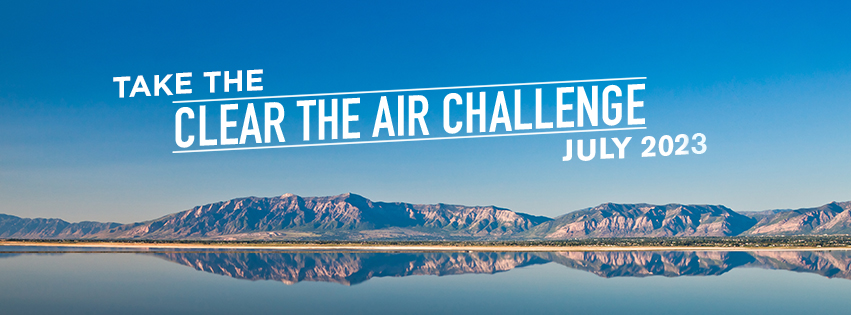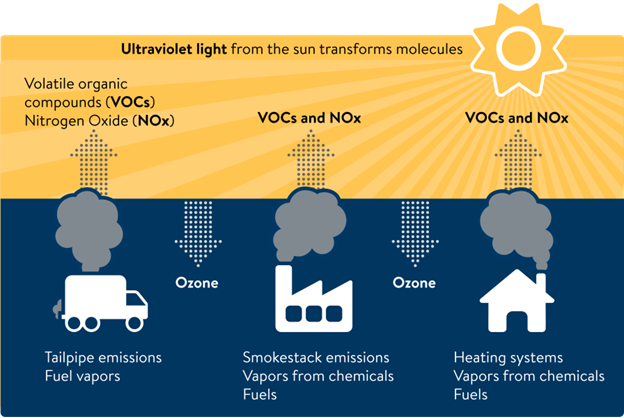by SLCgreen intern Charlie Bonkowsky

It’s almost time for The Clear The Air Challenge—an annual event encouraging Utahns to reduce their vehicle emissions and help keep Utah’s air clean! The competition starts on July 1st and runs throughout the month, with a goal this year of eliminating 100,000 single-car trips and keeping 375 tons of CO2 out of the atmosphere.
With that on the horizon, SLCgreen wanted to take a look at what types of air pollution might also be on our horizons, both in summer and in winter, and what you and the city can do about it!
Winter Inversions
The Salt Lake Valley’s most visible struggles with clean air are in the winter, when inversions see a thick layer of smog and haze across the valley. Inversions occur when a layer of warm air traps colder air beneath it. In the Salt Lake Valley, that cold air cannot escape the mountains surrounding it, so pollution and emissions build up near the ground in that trapped layer of air.
SLCgreen explored the subject in depth last year, but, in short, the greatest health risk during inversions are particles 30 times smaller than a grain of sand, known as PM2.5. Breathing too much PM2.5 can irritate your throat and lungs, as well as cause a host of more severe heart and lung problems.
To keep yourself safe and healthy during winter inversions, Salt Lake City recommends wearing a high-filtration mask outdoors or staying inside to avoid pollution. Wintertime PM2.5 breaks down inside due to the temperature change, but a high-performance furnace air filter (ideally MERV 13 or better) will still help keep your home air cleaner.
Summer Ozone & Wildfire Smoke
Our skies usually look a lot less hazy in the summer—but that doesn’t mean they’re clean! High temperatures and strong sunlight can lead to the formation of ground-level ozone from common types of emissions.

Ozone is odorless and invisible, but, like PM2.5, ozone is unhealthy in high concentrations. The gas acts like a sunburn in the lungs, causing coughing, throat or chest pain, and congestion, and may cause flare-ups of any existing respiratory diseases.
When our summer skies are dirty, it’s usually because of wildfire smoke. Whether smoke ends up in the valley depends on a range of meteorological conditions—but when those conditions line up right, smoke from thousands of miles away can find its way here. In August 2021, for example, wildfires on the West Coast gave Salt Lake City the worst air quality in the world.
(But it’s not all from distant fires—every year, particulate concentrations in the air go up following July 4th and 24th, as people light fireworks and release smoke into the air.)
Like wintertime PM2.5, ground-level ozone breaks down indoors once it’s out of the sunlight. Wildfire smoke, however, does not—making air filtration even more important during summertime wildfire events. To improve your indoor air quality during wildfire events, use a high-performance air filter and change it regularly, and avoid measures that bring in air from outside the home: limit the use of swamp coolers and try not to open windows. If you don’t have AC that can recirculate air in the house, consider stopping by a Cool Zone instead. Check out our Indoor Air Quality tips for more information.
Clearing Our Air
Around 50% of the pollution in the valley comes from transportation, no matter the time of year. That’s why it’s so important to reduce the number of car trips we take, and that’s exactly what The Clear The Air Challenge is encouraging us all to do!
There are several different ways you can reduce your vehicle emissions:
- Biking or walking: these active modes of transportation emit almost no CO2 and help improve your health. GREENbike Utah is making it even easier to bike by offering monthly bike passes for the whole of July for just $5 with the code CLEARTHEAIR23.
- Carpooling or vanpooling: traveling with friends or coworkers saves time and cuts down on fuel costs. If you don’t know who you might carpool with, you can use a carpool-matching website —and maybe make some new friends!
- Using public transit: between bus routes, TRAX extensions, and the FrontRunner, public transit offers an inexpensive and convenient way to avoid driving.
- Trip chaining: by grouping errands or other activities into a singular trip, rather than returning home in between, you can avoid a whole host of needless trips and save money on fuel.
- Teleworking or skipping the trip: by not going into work, or not going on another trip, you avoid the emissions caused by driving somewhere.
Salt Lake City and its 3,000 employees are participating in the Clear The Air Challenge again this year: “We can all make a difference to our air by making small, and sometimes very large, decisions about how we get around,” said Mayor Erin Mendenhall. “Please join me and my fellow city employees as we compete in the challenge.”
You can sign up for the challenge and track your trips through the Travelwise Tracker, which will also give you the opportunity to win prizes for the trips you save! You can participate in the challenge as an individual or, when you sign up, register with a business, company, or even a group of friends! If you don’t see your group listed, you can email info@cleartheairchallenge.org to set up the network. Or, if you want, you can join the public ‘SLCGreen’ group and compete along with all of us!
For more information on what Salt Lake City is doing to clear the air visit our Air Quality landing page.
